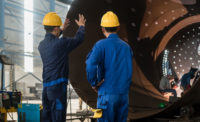NDT HEADLINE
YXLON Publishes New Computed Tomography Handbook

YXLON's new “Computed Tomography (CT) for Industrial Applications Handbook” explains the process of CT scanning and to use it for industrial applications. Busy engineers who are either experienced or novices at imaging will find simple methods and approaches for applying CT scanning technology their industrial parts and sub-components, according to a post on YXLON's website.
X-Rays in 3D: What Is CT Scanning?
CT starts by scanning an object and generating a series of 1D and 2D images at different angles, YXLON's blog post described. The separate images are assembled into one 3D representation of the scanned object using powerful imaging software. These images, called “tomograms,” are taken using X-ray scanning, usually through a full 360-degree rotation and represent “slices” of the full 3D representation of the scanned object. The brighter the gray areas are in an image, the denser they are. Black is negative space. From these slices, the final 3D image is rendered, providing actual insight without destroying the item being imaged. Known as “volume rendering,” these pictures can have realistic shadows, opacity, camera angles, and more. Many times, even the 2D images are enough for engineers to get the information they need.
CT dates back to the early 1970s, with research by Godfrey Hounsfield and Allan Cormack, who eventually won the Nobel Prize in Physiology in 1979 for their work in using CT on the human brain. Its applications have since then extended beyond the human brain into various industrial and research applications.
Metrology
CT scanning allows the inspection of raw materials, end products, and molds, along with other parts used in industry to ensure they meet quality and reliability standards without having to disassemble or destroy them. Engineers can get an inside look at construction techniques, for example, to see how well a weld has been applied between two pieces of metal, or to see if a critical jet engine fan blade has any hairline cracks. It can show porosity levels in rubber, and examine new, lightweight parts for automobiles. Using CT scanning can help catch problems early before they turn into critical failures.
One of the most notable benefits CT provides is its ability to allow engineers to see densities. That means, for example, engineers can see inside injection molded and 3D-printed plastic parts where voids and porosity are, as well as cracks, flaws and other manufacturing defects using this non-destructive testing method.
In metrology, CT can easily allow comparisons between surfaces. Two CT scans can be compared to each other, or they can be compared to CAD (computer aided design) drawings. The differences can be displayed by color for fast, easy identification.
CT scans are also used in the analysis of concrete and structures. In these applications, the scans can help to show how fluid moves through core samples, to evaluate how concrete behaves before and after stress and fatigue tests, and to examine aggregate. CT scans can also allow inspection of lightweight materials used to reduce weight in automobiles, aircraft, spacecraft, and other vehicles.
Beyond inspection and quality control, CT scanning can aid in reverse engineering. Engineers can get a literal inside look at a part without having to disassemble or destroy it. Using CT scans, internal geometries and material densities are easily visible. The data gathered makes it far simpler to understand how a particular part functions or if it meets necessary specifications. Computer software even exists for edge detection, if this is required.
Learn More
These are just some examples of what can be accomplished with CT scanning. For a full overview of applications, and to learn how CT can be of benefit to your single sample or production needs, download the YXLON CT Handbook.
Looking for a reprint of this article?
From high-res PDFs to custom plaques, order your copy today!








